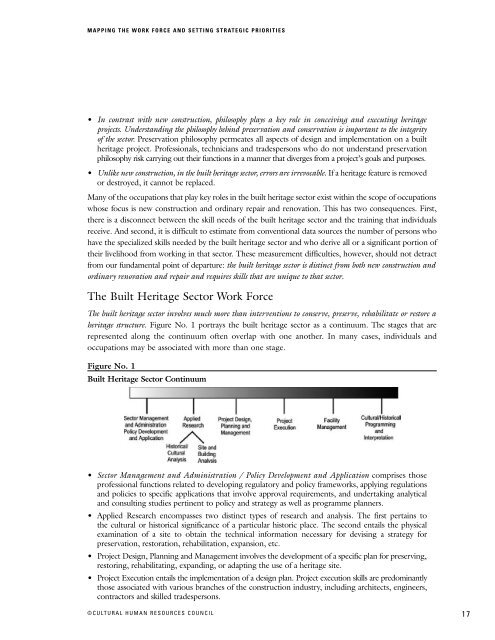Human Resources in Canada's Built Heritage Sector: Mapping the ...
Human Resources in Canada's Built Heritage Sector: Mapping the ...
Human Resources in Canada's Built Heritage Sector: Mapping the ...
- No tags were found...
Create successful ePaper yourself
Turn your PDF publications into a flip-book with our unique Google optimized e-Paper software.
MAPPING THE WORK FORCE AND SETTING STRATEGIC PRIORITIES• In contrast with new construction, philosophy plays a key role <strong>in</strong> conceiv<strong>in</strong>g and execut<strong>in</strong>g heritageprojects. Understand<strong>in</strong>g <strong>the</strong> philosophy beh<strong>in</strong>d preservation and conservation is important to <strong>the</strong> <strong>in</strong>tegrityof <strong>the</strong> sector. Preservation philosophy permeates all aspects of design and implementation on a buil<strong>the</strong>ritage project. Professionals, technicians and tradespersons who do not understand preservationphilosophy risk carry<strong>in</strong>g out <strong>the</strong>ir functions <strong>in</strong> a manner that diverges from a project’s goals and purposes.• Unlike new construction, <strong>in</strong> <strong>the</strong> built heritage sector, errors are irrevocable. If a heritage feature is removedor destroyed, it cannot be replaced.Many of <strong>the</strong> occupations that play key roles <strong>in</strong> <strong>the</strong> built heritage sector exist with<strong>in</strong> <strong>the</strong> scope of occupationswhose focus is new construction and ord<strong>in</strong>ary repair and renovation. This has two consequences. First,<strong>the</strong>re is a disconnect between <strong>the</strong> skill needs of <strong>the</strong> built heritage sector and <strong>the</strong> tra<strong>in</strong><strong>in</strong>g that <strong>in</strong>dividualsreceive. And second, it is difficult to estimate from conventional data sources <strong>the</strong> number of persons whohave <strong>the</strong> specialized skills needed by <strong>the</strong> built heritage sector and who derive all or a significant portion of<strong>the</strong>ir livelihood from work<strong>in</strong>g <strong>in</strong> that sector. These measurement difficulties, however, should not detractfrom our fundamental po<strong>in</strong>t of departure: <strong>the</strong> built heritage sector is dist<strong>in</strong>ct from both new construction andord<strong>in</strong>ary renovation and repair and requires skills that are unique to that sector.The <strong>Built</strong> <strong>Heritage</strong> <strong>Sector</strong> Work ForceThe built heritage sector <strong>in</strong>volves much more than <strong>in</strong>terventions to conserve, preserve, rehabilitate or restore aheritage structure. Figure No. 1 portrays <strong>the</strong> built heritage sector as a cont<strong>in</strong>uum. The stages that arerepresented along <strong>the</strong> cont<strong>in</strong>uum often overlap with one ano<strong>the</strong>r. In many cases, <strong>in</strong>dividuals andoccupations may be associated with more than one stage.Figure No. 1<strong>Built</strong> <strong>Heritage</strong> <strong>Sector</strong> Cont<strong>in</strong>uum• <strong>Sector</strong> Management and Adm<strong>in</strong>istration / Policy Development and Application comprises thoseprofessional functions related to develop<strong>in</strong>g regulatory and policy frameworks, apply<strong>in</strong>g regulationsand policies to specific applications that <strong>in</strong>volve approval requirements, and undertak<strong>in</strong>g analyticaland consult<strong>in</strong>g studies pert<strong>in</strong>ent to policy and strategy as well as programme planners.• Applied Research encompasses two dist<strong>in</strong>ct types of research and analysis. The first perta<strong>in</strong>s to<strong>the</strong> cultural or historical significance of a particular historic place. The second entails <strong>the</strong> physicalexam<strong>in</strong>ation of a site to obta<strong>in</strong> <strong>the</strong> technical <strong>in</strong>formation necessary for devis<strong>in</strong>g a strategy forpreservation, restoration, rehabilitation, expansion, etc.• Project Design, Plann<strong>in</strong>g and Management <strong>in</strong>volves <strong>the</strong> development of a specific plan for preserv<strong>in</strong>g,restor<strong>in</strong>g, rehabilitat<strong>in</strong>g, expand<strong>in</strong>g, or adapt<strong>in</strong>g <strong>the</strong> use of a heritage site.• Project Execution entails <strong>the</strong> implementation of a design plan. Project execution skills are predom<strong>in</strong>antlythose associated with various branches of <strong>the</strong> construction <strong>in</strong>dustry, <strong>in</strong>clud<strong>in</strong>g architects, eng<strong>in</strong>eers,contractors and skilled tradespersons.©CULTURAL HUMAN RESOURCES COUNCIL17










